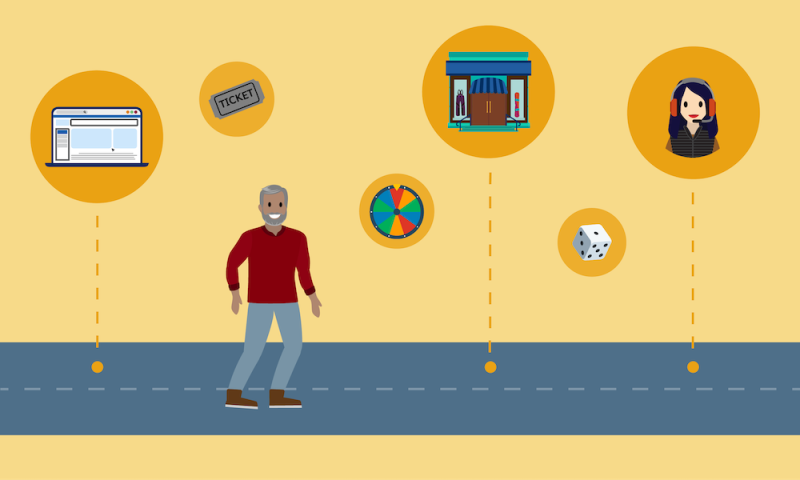Boost Customer Loyalty with Gamification
Learning Objectives
After completing this unit, you’ll be able to:
- Explain the need for gamification in business.
- Explore how gamification engages customers through different business scenarios.
- Sign up for a special developer edition org with Loyalty Management.
Why Gamify?
As a customer, shopping for accessories or booking a flight for a holiday is often an enjoyable experience. But what if these activities were presented as a fun challenge where every action gets the customer closer to a special prize? The customer is more likely to return for repeat purchases and stay engaged with the brand.

Adding a bit of surprise and excitement is a great way for businesses to grab customers' attention and keep them interested. One powerful way to do that is by integrating game-like elements, such as daily challenges, leaderboards, or quests, into the customer experience.
Gamification taps into the natural human desire for achievement and recognition, making interactions with the business more enjoyable and memorable. Engaged customers are more likely to make repeat purchases, act as brand advocates, and develop strong emotional connections with the brand. So gamification builds long-term loyalty and boosts revenue. But that’s not all—here are some other benefits.
Improve impact with data: Businesses can reward customers with a game for engaging with their content, such as watching a video or completing a survey. These game elements are used to gather zero and first-party data, which provides valuable insights to enhance marketing strategies and improve customer experiences.
Reduce discount dependency: To boost sales of a specific product, businesses can offer customers a game with their purchase instead of a discount. By offering engaging experiences, businesses can shift the focus from discounts and decrease the need for frequent price cuts.
Promote smaller, frequent redemptions: Businesses can encourage their loyalty program members to use their points for a chance to win a game. By nudging members to participate, even if they haven’t accumulated enough points, businesses reduce the build-up of large point balances. At the same time, by encouraging members to use their points for a game, the business reduces its points liability.
In short, gamification helps businesses create engaging and effective customer experiences for long-term success.
Next, let’s explore an example of how a business creates immersive and effective experiences with gamification.
Gamified Promotions at Cloud Kicks
Cloud Kicks, a renowned sneaker manufacturer, recently launched the Super Kicks line of shoes, which has been well-received by customers. However, the company wants to boost engagement to reach a wider audience, without relying on discounts. The marketing team brainstorms ideas and finally decides to add games to its loyalty program, Cloud Kicks Inner Circle.
The Cloud Kicks Inner Circle program is built on Salesforce Loyalty Management, and offers evolved benefits, experiential rewards, badges, and more. To make the program more engaging and fun, Cloud Kicks plans to use Loyalty Management’s gamification feature to offer members games like Spin the Wheel and Scratchcard. Through these games, it can offer points, vouchers, and other custom rewards.
Creating a game involves multiple steps. First, develop the rules for how members play the game, including how they complete challenges and earn rewards. Next, define the rewards members can earn by participating in the game, such as points, discounts, exclusive access, and more. Finally, deploy the games onto ecommerce or experience sites where members interact with the games.
The marketing team, in collaboration with the loyalty team, finalizes the rules and rewards for the games. They want to launch a promotion for Super Kicks during the year-end holiday season. Members who purchase Super Kicks during the promotion period get exclusive access to play a Spin the Wheel game.
In this module, follow along as Mary Levy, the loyalty program manager at Cloud Kicks, sets up the game and its rewards.

Sign Up for a Developer Edition Org with Loyalty Management
To complete this module, you need a special Developer Edition org that contains Loyalty Management and our sample data. Get the free Developer Edition and connect it to Trailhead now so you can complete the challenges in this module. Note that this Developer Edition is designed to work with the challenges in this badge, and may not work for other badges. Always check that you’re using the Trailhead Playground or special Developer Edition org that we recommend.
- Sign up for a free Developer Edition org with Loyalty Management.
- Fill out the form:
- For Email, enter an active email address.
- For Username, enter a username that looks like an email address and is unique, but it doesn’t need to be a valid email account (for example, yourname@lm4ever.com).
- For Email, enter an active email address.
- After you fill out the form, click Sign me up. A confirmation message appears.
- When you receive the activation email (this might take a few minutes), open it and click Verify Account.
- Complete your registration by setting your password and challenge question. Tip: Save your username, password, and login URL in a secure place—such as a password manager—for easy access later.
- You are logged in to your Developer Edition.
Now connect your new Developer Edition org to Trailhead.
- Make sure you're logged in to your Trailhead account.
- In the Challenge section at the bottom of this page, click the playground name and then click Connect Org.
- On the login screen, enter the username and password for the Developer Edition you just set up.
- On the Allow Access? screen, click Allow.
- On the Want to connect this org for hands-on challenges? screen, click Yes! Save it. You're redirected back to the challenge page and ready to use your new Developer Edition to earn this badge.
You’re all set. In the next unit, you explore the records involved in the gamification process, create a game, and set up its rewards.